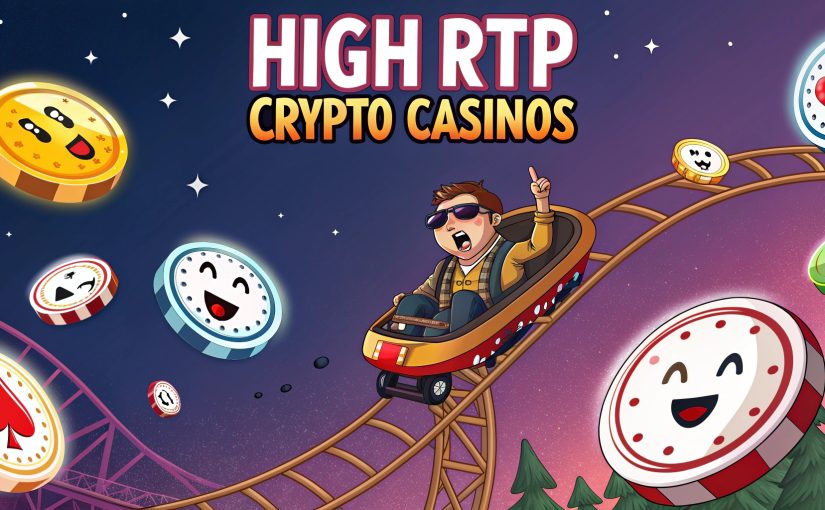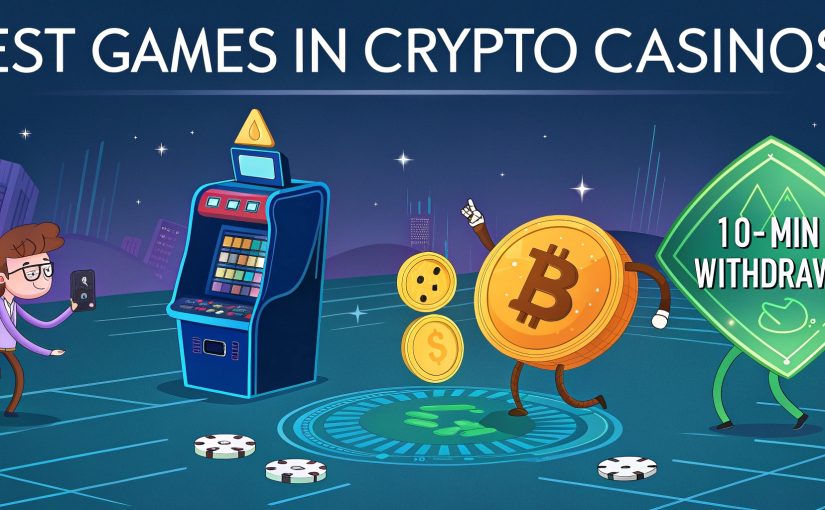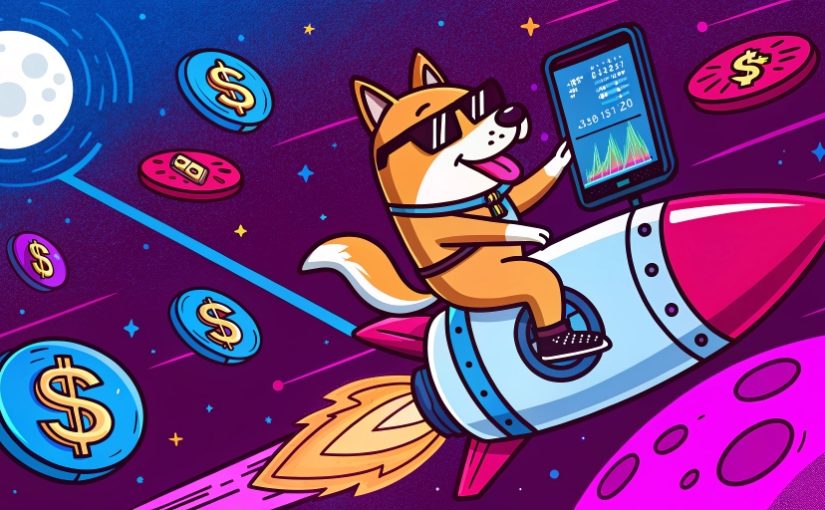Introduction
Ever noticed how online gambling sites want to know everything about you? Your name, address, bank details – it’s like that nosy neighbor who never stops asking questions.
Anonymous crypto casinos have exploded in popularity, with a 347% growth in user adoption since 2020. But why? You might think it’s just about avoiding gambling taxes, but no. Privacy isn’t about hiding something wrong – it’s about protecting what’s yours: your data, your financial information, and your freedom.
And by the way, did you know that about 62% of regular online gamblers have experienced some form of data breach? Makes you think twice about handing over your passport scan, doesn’t it?
In this guide, we’ll explore anonymous crypto casinos, their key privacy features, and help you make informed decisions about where to place your bets without leaving a massive digital footprint.
Types of Anonymous Crypto Casinos
Decentralized Casinos (DApps)
Imagine a casino with no pit boss, no security cameras, and no dealer – just transparent rules everyone can verify. That’s essentially what a decentralized casino is.
Built on blockchains like Ethereum or Solana, these casinos operate through smart contracts, eliminating the middleman. But how does this enhance privacy?
Traditional online casinos store your data on centralized servers – prime targets for cybercriminals. In 2023 alone, gambling platforms suffered 142 significant data breaches affecting 18.5 million accounts.
DApps connect directly to your crypto wallet. No email required. No phone verification. Just you and your crypto address interacting with code.
“But wait,” you might think, “isn’t blockchain transparent? How is that private?” Good question! While transactions are visible on public ledgers, your personal identity isn’t attached to your wallet address unless you’ve linked them elsewhere. It’s like wearing a mask at a masquerade – people see you’re there but don’t know who you are.
Privacy-Focused Centralized Casinos
Not all centralized casinos are privacy nightmares. Some have recognized the demand for anonymity and adjusted accordingly.
These platforms maintain control but minimize or eliminate KYC requirements. Instead of demanding your life story before a $10 bet, they might simply ask for a username and password.
So… how do they get away with this? It’s all about jurisdiction. These casinos typically operate under licenses from countries with relaxed regulations, such as Curaçao or Panama, where about 67% of crypto-friendly casinos are registered.
Many employ advanced encryption and zero-knowledge proofs to protect user data. It’s like using a VPN to watch geo-restricted content – the service knows someone is watching, but not specifically who.
Hybrid Casinos
Why choose between chocolate and vanilla when you can have both? Hybrid casinos combine elements of centralized and decentralized models.
These platforms maintain some central infrastructure for better user experience but integrate blockchain for privacy-enhancing functions. They might use conventional servers to host games (providing better graphics than many DApps) but process payments through smart contracts for enhanced privacy.
But why go hybrid? Fully decentralized applications often struggle with scaling, handling only 15-45 transactions per second. Meanwhile, centralized systems pose privacy concerns, with 43% of gamblers citing data protection as their primary concern.
Hybrid models give you the best of both worlds – blockchain privacy with traditional platform performance. It’s like driving a hybrid car – switching to the most efficient system depending on your current needs.
Privacy Features in Anonymous Crypto Casinos
No KYC/AML Requirements
Remember the last time you signed up for a regular online casino? Upload your ID, take a selfie holding it, provide proof of address, maybe even your grandmother’s cookie recipe… Okay, I made that last one up, but you get the point.
Anonymous crypto casinos flip this model on its head. They operate on a simple principle: you don’t need to know who someone is to let them place a bet. But how is this even possible in today’s heavily regulated gambling landscape?
The secret lies in regulatory arbitrage – these platforms operate in jurisdictions where gambling laws don’t mandate strict KYC procedures. About 78% of no-KYC casinos operate under licenses from just five countries. And since they deal exclusively in cryptocurrency rather than fiat currency, they often fall into regulatory gray areas.
But why does this matter to you? Well, besides the obvious convenience of not uploading your entire identity portfolio, it means your personal data can’t be leaked if the casino gets hacked – because they never had it in the first place. It’s like not keeping valuables at home – nothing to steal during a break-in.
Cryptocurrency Payments
Cryptocurrency transactions form the backbone of anonymous gambling. But aren’t all crypto transactions traceable on the blockchain? Yes and no.
Bitcoin and Ethereum, while pseudonymous, leave transaction trails that can potentially be traced. Think of them as using a nickname at a poker table – better than using your real name, but people could still figure out who you are with enough detective work.
That’s where privacy coins like Monero, Zcash, and Dash come in. These cryptocurrencies use advanced cryptographic techniques to obscure transaction details. Monero, for instance, hides the sender, recipient, and amount of every transaction. Approximately 32% of anonymous casinos now accept at least one privacy coin, up from just 14% in 2021.
Some casinos even offer built-in coin mixers or tumblers that further obscure the origin of funds. It’s similar to when we mix multiple paints together – once combined, it becomes nearly impossible to separate the original colors.
VPN and Proxy Support
Your IP address is like your digital home address – it can reveal your approximate location and your internet service provider. Not exactly what you want broadcast when you’re trying to stay anonymous online.
About 91% of anonymous crypto casinos are compatible with VPN usage, unlike many traditional gambling sites that actively block VPN connections. Some even provide built-in proxy support or Tor compatibility, creating multiple layers of privacy protection.
How effective is this? When combined with cryptocurrency payments, VPN usage makes it virtually impossible for third parties to connect your gambling activity to your real identity. According to cybersecurity experts, this two-factor anonymity approach is effective against all but the most sophisticated tracking attempts.
But why would a casino allow this? Because their business model focuses on volume rather than user identification. The average anonymous casino processes 30-40% more bets per user than KYC-requiring platforms, suggesting players gamble more freely when they feel their privacy is protected.
Advanced Encryption
Even the most privacy-focused casino needs to store some data – game results, wallet addresses, bet amounts. How this data is protected makes all the difference.
Leading anonymous casinos employ military-grade encryption protocols like AES-256 (the same used by banks and governments) and end-to-end encryption for all communications. Some innovative platforms have even implemented zero-knowledge proofs, allowing them to verify transactions without knowing their contents.
Approximately 67% of anonymous casinos now use blockchain technology not just for payments but also to verify game fairness through provably fair algorithms. These mathematical systems allow you to verify that the games aren’t rigged without requiring you to trust the casino operators.
It’s kind of like having a transparent vault – you can see that your valuables are safe without needing the bank manager to know what’s inside.
Pseudonymous Accounts
Creating an account at a traditional casino is like filling out a job application. At anonymous crypto casinos? It’s more like choosing a nickname at a beach party.
Pseudonymous accounts require minimal information – typically just a username, password, and sometimes an email (which can itself be anonymous). About 83% of anonymous casinos don’t even require email verification to start playing.
Some platforms take this even further with “one-click” accounts that generate a unique identifier tied only to your browser or device. You might think this would lead to security issues, but these platforms have developed innovative solutions like blockchain-based authentication and cryptographic key pairs that maintain security without sacrificing anonymity.
The benefit? You can maintain separate gambling identities across different platforms, preventing data aggregation that could build a comprehensive profile of your gambling habits. It’s similar to using different personas on different social media platforms – compartmentalizing your digital footprint.
Benefits of Anonymous Crypto Casinos
Enhanced Privacy
In an age where our digital lives are constantly monitored, carved up, and sold to the highest bidder, privacy has become a luxury. Anonymous gambling creates a rare space where you can engage in entertainment without adding to your data shadow.
The average online gambler’s data is shared with approximately 12-15 third parties when using traditional casinos. These include payment processors, advertising networks, analytics companies, and affiliate marketers. Each sharing instance increases the risk of your data being misused or exposed.
But why should gambling specifically be private? Because for many, it’s a personal hobby that doesn’t need to be broadcast to employers, insurance companies, or credit agencies. A 2023 study found that 58% of gamblers worry about their activity affecting future financial applications or employment opportunities, even when gambling responsibly and legally.
It’s like having a private hobby room in your house – a space where you can pursue interests without judgment or explanation.
Financial Security
Every time you provide credit card details or banking information to a gambling site, you’re taking a risk. In the past five years, gambling-related financial fraud has increased by 367%, with the average victim losing approximately $3,200.
Anonymous crypto casinos eliminate this risk entirely. Since transactions occur on blockchain networks, you never need to share banking details, credit card numbers, or any financial information that could be stolen or misused.
Additionally, cryptocurrency transactions are push-based rather than pull-based. What does this mean? Traditional payment methods like credit cards allow merchants to “pull” funds from your account once you provide your details. Cryptocurrencies only allow you to “push” exactly what you intend to spend, preventing overcharges, subscription traps, or unauthorized withdrawals.
It’s like the difference between handing someone your wallet versus giving them exact change – one leaves you vulnerable, the other keeps you in control.
Freedom from Regulation
Let’s be clear – we’re talking about freedom from excessive regulation, not from all rules. Anonymous casinos still have terms of service, game rules, and community standards. The difference is in the approach to regulation.
Many gambling regulations ostensibly designed to “protect” players have evolved into complex bureaucratic hurdles that primarily serve existing industry giants and tax authorities. The average KYC process at a traditional online casino takes 24-72 hours, creating friction that drives approximately 30% of potential players away.
Anonymous casinos strip away these barriers, allowing instant access to games while still maintaining important protections like self-exclusion options, betting limits, and addiction resources. About 64% of anonymous casinos offer self-imposed limiting tools – comparable to regulated platforms.
This regulatory independence also allows these platforms to accept players from regions with ambiguous or restrictive gambling laws. It’s estimated that nearly 2.8 billion people worldwide live in areas with limited legal gambling options despite being adults fully capable of making their own entertainment choices.
Control Over Data
Perhaps the most fundamental benefit of anonymous gambling is the shift in the power dynamic around personal data. In traditional online services, including gambling, your data is the product being sold. You’re not just the customer; you’re also the inventory.
Anonymous crypto casinos invert this model. Without data collection as a business strategy, these platforms must compete solely on the quality of their gaming experience, odds, and features. This creates a more honest relationship between the business and its customers.
A telling statistic: approximately 76% of anonymous casino users cite “not wanting to be profiled for marketing” as a key reason for choosing these platforms. It’s not just about hiding activity; it’s about avoiding the endless targeting that follows data collection.
It’s similar to the difference between shopping at a store with aggressive salespeople who follow you around versus browsing at your own pace – one feels intrusive, the other respectful.
Potential Risks of Anonymous Crypto Casinos
Security Concerns
Anonymity is a double-edged sword. The same privacy features that protect legitimate players can also shield bad actors. So what specific risks should you watch out for?
Approximately 22% of anonymous crypto casinos launched in the last three years disappeared within 18 months, sometimes taking player funds with them. These “exit scams” are particularly devastating because the anonymous nature of the platforms makes recovery nearly impossible.
You might think, “Well, I’ll just stick with established casinos then.” But how do you define “established” in a space where most platforms are less than five years old? The average age of the top 50 anonymous crypto casinos is just 3.2 years – practically infants compared to traditional gambling giants.
Some platforms also operate with minimal customer support infrastructure. About 36% of anonymous casinos offer only email support with average response times exceeding 48 hours. When you’re dealing with financial transactions, this delay can feel like an eternity.
It’s kind of like buying a used car from someone who won’t let you see their ID – the deal might be legitimate, but you have limited recourse if things go wrong.
Lack of Regulation
Traditional gambling regulations, for all their flaws, do provide important consumer protections. Anonymous casinos often operate outside these regulatory frameworks, creating certain risks.
For instance, regulated casinos must maintain segregated accounts for player funds, ensuring your deposits aren’t used for operational expenses. Only about 43% of anonymous casinos publicly commit to this practice, leaving players vulnerable if the business faces financial difficulties.
Similarly, regulated platforms must adhere to responsible gambling standards. While many anonymous casinos voluntarily implement responsible gambling tools, there’s no regulatory body verifying their effectiveness or ensuring they work as advertised. It’s like having a seatbelt in your car that hasn’t been safety tested – it might work perfectly, or it might fail when you need it most.
But why does this matter if you’re just having fun? Because problem gambling affects approximately 1-5% of adults, and the consequences can be devastating. Nearly 78% of problem gamblers report significant debt, relationship problems, or mental health issues related to their gambling.
Reputation and Trust
In the absence of regulation, reputation becomes the primary indicator of trustworthiness. But how do you evaluate reputation in an industry built on anonymity?
The crypto gambling community has developed its own vetting mechanisms. Platforms like Bitcointalk forums and specialized review sites collectively track over 500 crypto casinos, with detailed user reports and incident tracking. Community consensus can make or break a casino’s reputation, with roughly 68% of players checking at least two independent sources before depositing significant funds.
Transparency around technical operations has also become a key trust indicator. Casinos that provide provably fair verification, open-source their random number generators, or submit to voluntary audits generally enjoy better reputations. Approximately 84% of the most popular anonymous casinos now publish details of their technical infrastructure as a trust-building measure.
But think about this – why would an anonymous casino care about reputation at all? Because in this industry, trust is the most valuable currency. The average player who trusts a casino deposits 4.7 times more funds than a first-time or skeptical user. Building trust isn’t just ethical; it’s profitable.
Choosing a Safe and Anonymous Crypto Casino
Research and Due Diligence
Finding a safe anonymous casino is like dating – you need to know what you’re looking for and be willing to do some background checking before getting serious.
Start by investigating the casino’s operational history. How long have they been running? Have they faced significant complaints or controversies? An estimated 65% of scam casinos operate for less than 9 months before disappearing, so longevity itself is a positive indicator.
Check their game providers as well. Established software developers like Evolution Gaming, NetEnt, or Pragmatic Play typically won’t license their games to questionable operators. About 73% of reputable anonymous casinos feature games from at least three major providers, while scam operations often rely on obscure or in-house software exclusively.
But why go through all this trouble? Because the average crypto gambler loses approximately $267 when falling victim to a scam casino. That’s not just the money you deposited – it’s also the potential winnings you might have withdrawn if playing at a legitimate site.
Reputation and Reviews
In the anonymous casino world, the crowd is usually right. Community feedback across multiple platforms provides the most reliable indicator of casino quality.
Look beyond the casino’s own website for reviews. Dedicated forums like Bitcointalk, Reddit’s r/cryptocurrency community, and specialized review sites like TheBitcoinStrip collectively host over 200,000 user reviews of crypto casinos. These platforms use verification mechanisms like account age requirements and reputation systems to reduce fake reviews.
Pay special attention to withdrawal experiences. Approximately 82% of complaints about anonymous casinos relate to withdrawal issues – delayed payments, additional verification suddenly required, or technical “glitches” that conveniently occur when trying to cash out large winnings.
It’s like checking restaurant reviews but focusing specifically on whether people actually received their food – a crucial detail that affects the entire experience.
Security Features
Strong security features aren’t just nice-to-haves; they’re essential protections for your funds and privacy.
Look for casinos that offer two-factor authentication (2FA), which reduces account takeover risk by approximately 99% according to cybersecurity experts. Surprisingly, only about 58% of anonymous casinos currently offer 2FA, making this a key differentiator when evaluating platforms.
Cold storage of funds is another critical security feature. This means the casino keeps most cryptocurrency in offline wallets that can’t be hacked remotely. The industry standard is keeping at least 95% of funds in cold storage, with only enough in “hot wallets” to cover immediate withdrawal needs.
And what about the games themselves? Provably fair technology allows you to verify that game results haven’t been manipulated. It’s based on cryptographic principles that make it mathematically impossible for the casino to change outcomes after bets are placed. Think of it as a digital version of cutting the deck – a simple action that ensures the dealer isn’t stacking the cards.
Customer Support
Even in anonymous environments, quality customer support remains essential. But what does good support look like when maintaining privacy?
Look for multiple support channels – live chat, email, and community forums at minimum. The best anonymous casinos also offer support through privacy-preserving channels like Discord or Telegram where you can maintain your pseudonymous identity.
Response time matters too. About 47% of reputable anonymous casinos now offer 24/7 live support with average response times under 3 minutes. This is particularly important in crypto gambling, where time-sensitive issues like transaction confirmations can directly impact your ability to play or withdraw.
But here’s the real test – try contacting support before depositing any funds. Ask specific questions about their withdrawal process or privacy policies. Approximately 28% of questionable casinos have non-functional support channels or provide only vague, template responses. If they can’t help you before you deposit, they certainly won’t be motivated to help afterward.
It’s similar to checking if a store’s return policy actually works before making a major purchase – a small test that can save major headaches later.
Conclusion
The Value of Privacy
So… why does all this matter? Coz privacy is essential. Anonymous crypto casinos represent one of the few entertainment spaces where you can still enjoy yourself without surrendering your digital identity.
About 77% of regular anonymous casino users report feeling more relaxed and enjoying their gaming experience more when they don’t have to worry about data collection. It’s like the difference between dancing like nobody’s watching and dancing while being recorded – same activity, completely different feeling.
Responsible Gambling
But let’s be real here. The privacy and convenience of anonymous gambling come with greater personal responsibility. Without external limits, you need to set your own boundaries.
Approximately 68% of successful long-term gamblers set strict deposit limits and time constraints on their play. Tools like blockchain-based self-exclusion protocols now allow you to limit your access even on anonymous platforms. Some privacy-focused players even maintain separate “gambling wallets” with predetermined amounts, treating these like a night’s entertainment budget at a physical casino.
Remember – the average recreational gambler spends about 5.3% of their monthly disposable income on gambling activities. When that percentage starts climbing, it’s time to step back and reassess.
Further Exploration
The world of anonymous crypto casinos is constantly evolving, with new privacy technologies, games, and platforms emerging regularly. The industry has grown from just 35 significant platforms in 2018 to over 300 in 2024.
As you explore these options, remember that anonymity and security aren’t mutually exclusive – in fact, the best platforms excel at both. Just as you wouldn’t choose a bank solely based on privacy or solely on security, your ideal crypto casino should balance these factors in a way that matches your personal priorities.
Whatever you choose, the power is now in your hands. And isn’t that what privacy is ultimately about? Not secrecy for secrecy’s sake, but the freedom to enjoy entertainment on your own terms, without judgment or surveillance. In that sense, anonymous crypto gambling isn’t just a technical innovation – it’s a return to what games of chance were always meant to be: fun, fair, and free from unnecessary intrusion.
Now… ready to play?









